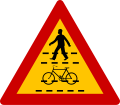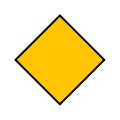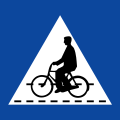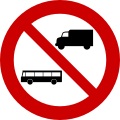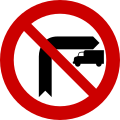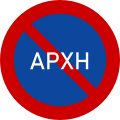
Road signs in Sweden are regulated in Vägmärkesförordningen, VMF (2007:90), and are to be placed 2 metres from the road with the sign 1.6 m from the base for motorized roads. Except for route numbers, there are a maximum of three signs on a pole, with the most important sign at the top. All signs have a reflective layer added on selected parts of the sign as is custom in European countries; most larger signs also have their own illumination.

Road signs in Iceland are visual communication devices placed along roads and highways throughout the country to provide information, warnings, and guidance to motorists and pedestrians. Iceland never ratified the Vienna Convention on Road Signs and Signals, but road signs in Iceland conform to the general pattern of those used in most other European countries, with certain design elements borrowed from Danish and Swedish practice. Signs tend to be more sparsely employed than in other European countries, especially in rural areas.

Road signs in Italy conform to the general pattern of those used in most other European countries, with the notable exception that the background of motorway (autostrada) signs is green and those for 'normal' roads is blue. They are regulated by the Codice della Strada and by the Regolamento di Attuazione del Codice della Strada in conformity with the 1968 Vienna Convention on Road Signs and Signals.

Road signs in South Korea are regulated by the Korean Road Traffic Authority.

Road signs in Finland were formerly regulated in Tieliikenneasetus (5.3.1982/182), but now are currently regulated in Siirtymäsäännökset (8.5.2020/360).

Road signs in the Czech Republic are regulated by the Ministry of Transport and the police. The signs are nearly the same as the European norm, but with small changes. The law governing the road signs is Decree number 30/2001 Sb., many times amended, and replaced by decree 294/2015 Sb., in force since 1 January 2016.

Road signs in New Zealand are similar to those set by the Vienna Convention on Road Signs and Signals. While New Zealand is not a signatory to the convention, its road signs are generally close in shape and function. New Zealand uses yellow diamond-shaped signs for warnings in common with Australia, the Americas, Ireland, Japan and Thailand. Speed limit signs are a red circle with a white background and the limitation in black, and are in kilometres per hour. There are also some signs unique to New Zealand. Road signs in New Zealand are controlled by NZ Transport Agency Waka Kotahi and are prescribed in the Land Transport Rule: Traffic Control Devices 2004 and set out in the Traffic Control Devices (TCD) Manual.

Road signs in Mauritius are standardised traffic signs used in Mauritius according to the Traffic Signs Regulations 1990. They are heavily modelled on road signs in the United Kingdom, since Mauritius is a former British colony and drives on the left.

Road signs in Cambodia are standardized road signs are similar to those used in Europe but much of it resembles road signage systems used in South American countries with certain differences. The designs of road signage match their neighbours of Thailand and Malaysia, both of which adopt a modified version of the South American road signage system. Until the early 1980s, Cambodia closely followed American, European, Australian, and Japanese practices in road sign design, with diamond-shaped warning signs and circular restrictive signs to regulate traffic. Unlike Thailand and Malaysia, Cambodia does not use the FHWA Series fonts typeface, favouring Helvetica instead.
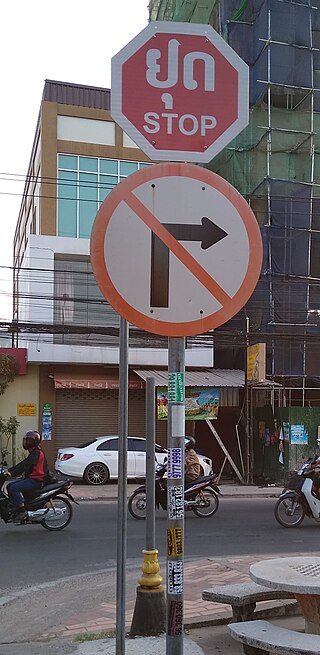
Road signs in Laos generally follow those used in most European countries as set out in the Vienna Convention on Road Signs and Signals. Despite this, the country itself has never signed the Vienna Convention on Road Signs and Signals. Inscriptions on traffic signs are in Lao, the national language of Laos. However, English is also used for stop and important public places such as tourist attractions, airports, railway stations, and immigration checkpoints. Both Lao and English are used on directional signage.

Road signs in Azerbaijan are similar to the road sign system of post-Soviet states that ensure that transport vehicles move safely and orderly, as well as to inform the participants of traffic built-in graphic icons. They generally conform to the Vienna Convention on Road Traffic and Vienna Convention on Road Signs and Signals.

Road signs in Vietnam follow Chinese and French road signs. Some signs are written in both Vietnamese and English. The signs are prescribed by the Vietnam Ministry of Transport with the 2019 standardization being the up-to-date regulations.

Road signs in Mongolia are similar to the Soviet and other European road sign systems. Road signs are regulated in the MNS 4597:2014 standard and conform to the general pattern of road signs as set out in the Vienna Convention on Road Signs and Signals. Despite the fact that Mongolia was never part of the Soviet Union, the MNS 4597:2014 standard for road signs has many similarities with its post-Soviet counterparts based on the Soviet standard ГОСТ 10807-78 and the Russian standard ГОСТ Р 52290-2004. Mongolia acceded to the Vienna Convention on Road Signs and Signals on December 19, 1997.

Road signs in Armenia are similar to the signs of other post-Soviet states and most European road sign systems. Armenia is a signatory of the Vienna Convention on Road Traffic and the Vienna Convention on Road Signs and Signals. The Ministry of Transport regulates these icons, while the police enforces them. Road signs ensure transport vehicles move safely and orderly, as well as, to inform both pedestrians and motorists of traffic rules.
Road signs in Saudi Arabia differ by locale, but they do tend to closely follow European practices with certain distinctions and conform to the general pattern as set out in the Vienna Convention of Road Signs and Signals. Road signs display text in Arabic language and English language. Distances are displayed in metric units and in Eastern Arabic numerals.

Road signs in Kazakhstan are similar to the road sign system of other post-Soviet states that ensure that transport vehicles move safely and orderly, as well as to inform the participants of traffic built-in graphic icons. These icons are governed by the Vienna Convention on Road Traffic and Vienna Convention on Road Signs and Signals. Road signs are regulated by the СТ РК 1125-2021 standard.

The road signs, used on the Serbian road network, are regulated by the "Regulation of Traffic Signs", which was last time modified in 2017.

Road signs in Latvia conform to the general pattern of those used in most other European countries. They are regulated in Ceļu satiksmes noteikumi and the standards documents LVS 77–1:2016 "Ceļa zīmes. 1. daļa: Ceļa zīmes", LVS 77-2:2016 "Ceļa zīmes. 2. daļa: Uzstādīšanas noteikumi" and LVS 77-3:2016 "Ceļa zīmes. 3. daļa: Tehniskās prasības" in conformity with the 1968 Vienna Convention on Road Signs and Signals. Latvia acceded to the Vienna Convention on Road Signs and Signals on October 19, 1992.

Road signs in Cyprus are regulated in Law of Street. They follow the road signs used in most European countries, including European Union countries, to which Cyprus joined in 2004, as set out in the Vienna Convention on Road Signs and Signals. Cyprus acceded to the Convention on 16 August 2016.
Albania is a signatory to the Vienna Convention on Road Signs and Signals. Therefore, road signs do not differ much from the rest of Europe, such as Italy, San Marino, Montenegro and Kosovo. The Ministry of Infrastructure and Energy regulates them. Albania drives on the right as with the rest of Europe, except for Cyprus, Ireland, Malta and the United Kingdom. Although Albania is not a member of the European Union, the road signs largely follow the general European conventions concerning the use of shape and colour to indicate their function.


























































